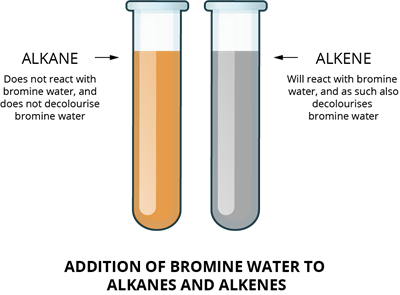
PUMPA - SMART LEARNING
எங்கள் ஆசிரியர்களுடன் 1-ஆன்-1 ஆலோசனை நேரத்தைப் பெறுங்கள். டாப்பர் ஆவதற்கு நாங்கள் பயிற்சி அளிப்போம்
Book Free DemoCharacteristics of hydrocarbons:
- Lower hydrocarbons, such as methane and ethane, are gases at room temperature.
- Hydrocarbons have no colour and no odour.
- The boiling point of hydrocarbons shoots up as the number of carbon atoms increases.
- Hydrocarbons undergo a combustion reaction with oxygen, resulting in the formation of CO_2 and water.
- When compared to other classes of hydrocarbons, alkanes are the least reactive. Because of the presence of the triple bond, alkynes are the most reactive.
- Alkanes are saturated compounds, whereas alkenes and alkynes are unsaturated compounds.
- Hydrocarbons are not soluble in water.
To identify saturated and unsaturated compounds, perform the following test:
Step 1: Place a sample solution in a test tube.
Step 2: Add a few drops of bromine water.
Observation: Observe for any noticeable colour change.

Reaction of hydrocarbon to bromine water
Result: If the given compound is unsaturated, it will decolourise bromine water, whereas saturated compounds will not.
Note: The reaction of hydrocarbon with bromine produces alkyl bromide. Unsaturated hydrocarbons like alkenes and alkynes are far more reactive than parent alkanes. They can quickly react with bromine.
For example, add a Br_2 molecule across the C=C double bond. This reaction can be used to detect alkenes or alkynes.
Alkanes do not undergo this reaction because they already have single bonds and thus cannot become more structurally stable or stronger. They are already at the peak and can only swap atoms around in substitution reactions.